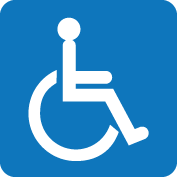Access to stops, stations and vehicles
We’re adapting our stops, stations, and vehicles for travellers with reduced mobility. This way, everyone can enjoy the vibrant energy of Brussels. Whether you have an intellectual, physical, auditory, or visual impairment, our close collaboration with the specialised organisation CAWaB ensures that you can travel to the maximum of your autonomy.
Accessible and practicable stops
As a wheelchair user, being confident about your route is crucial. That’s why we are committed to making sure all stops are accessible.
There are two types of stops:
- Accessible stops: they offer easy access to our vehicles without needing assistance. Ideal if you’re travelling alone.
- Practicable stops: you need assistance to access them, as their platforms are lower and the slopes steeper. In some cases, the pavement is too narrow or in poor condition, making it challenging to board the vehicle on your own.

The blue logo represents a wheelchair and is an accessible stop. These stops are accessible to persons in wheelchairs, even without assistance.

The orange logo represents a person pushing a wheelchair and corresponds to a passable stop. These stops are accessible to wheelchair users, with an accompanying person.
Assistance may be needed to compensate for a minor problem, where the stop does not fully comply with accessibility rules.
No symbol at the stop? In that case, the stop is not (yet) accessible or practicable for wheelchair users.
Safety tips to get around at bus and tram stops
Make your bus or tram journey smooth and safe with the following tips:
- Follow the tactile paving: If you’re blind, visually impaired, or have difficulty walking, stand by the front door of the bus or tram. The guiding lines on the ground are there to assist you. If you use a white cane, keep it unfolded to let the driver know you need extra time or assistance.
- Press the blue accessibility button: it’s located at the second door of our trams and buses. Press it to signal you need a ramp to board with a wheelchair. On buses, the driver will activate the ramp on request. If you’re boarding at practicable tram stops, a fellow traveller or an accompanying person can assist you with the portable ramp.
- Board at an accessible stop: no ramp is needed as the platform is at the same height as the bus or tram. This allows you to board and exit autonomously.

Accessible stations: STIB-MIVB stations with the grey wheelchair logo have lifts or ramps available. Check the exact location of these lifts on the district maps and use the STIB-MIVB app or website to see if they’re operational.
Accessible lines
Not sure if the stop where you're boarding or exiting is wheelchair-friendly? Check the accessibility of all tram and bus stops on the 'Lines' page by clicking on the toggle "PRM".
Good to know
Assistance in metro stations with lifts
Do you need help boarding or exiting the metro? You can request free assistance every day from 6.30 am to 11.00 pm. Simply go to the help point located at the accessible entrance of the station. Don't forget to validate your ticket before your journey!
It’s best to request assistance in advance so you won’t have to wait. You can book
- through the online form, or
- by phone at 02 515 23 65 (Monday to Friday from 7.00 am to 7.00 pm, and Saturday from 8.00 am to 4.00 pm).
If you're not in a hurry or didn’t make any booking, you can also request assistance by pressing the yellow button at the help points. You can find them at every accessible entrance of the station, just before the control line. They are marked with the “Help points” sticker. That way, someone can assist you as soon as possible.
Our advice
Accessible vehicles
As a person with reduced mobility, you can benefit from the following aids on board:
- Audio announcements in metros, trams, and buses: if you are visually impaired, you can rely on various speakers announcing the next stop. Nearly half of our buses and trams are also equipped with external speakers so you can clearly hear the line number and destination.
- Accessibility on buses: all buses are low-floor vehicles. That way, it’s easier for wheelchair users to board and exit using ramps. Our buses have a designated wheelchair area and six seats for travellers with reduced mobility.
- Wheelchair spaces on trams: the reserved spaces for wheelchair users are marked by serial numbers. They always start with 3 or 4. Did you know that most trams are also low-floor vehicles?
- Wider doors and metros: the latest metros on lines 1-5 are wider and closer to the platform, making boarding more accessible for wheelchair users.
- Wheelchair-friendly areas on metros: wheelchair spaces are located in the middle of the vehicle. For easy access, it’s best to wait in the middle of the platform. We will soon add markings on the metro gates and platforms to guide you on where to board more easily.
Our tip on the metro
Map and guide for travellers with reduced mobility
The pdf 'Guide for travellers with disabilities' is not accessible at this moment. A textual description is available here.
TaxiBus: public transport on request
Do you want to go on an outing, but taking public transport is too challenging for you or the person you're assisting? TaxiBus offers a door-to-door transportation service reserved for people with disabilities. The buses operate throughout the Brussels-Capital Region.

